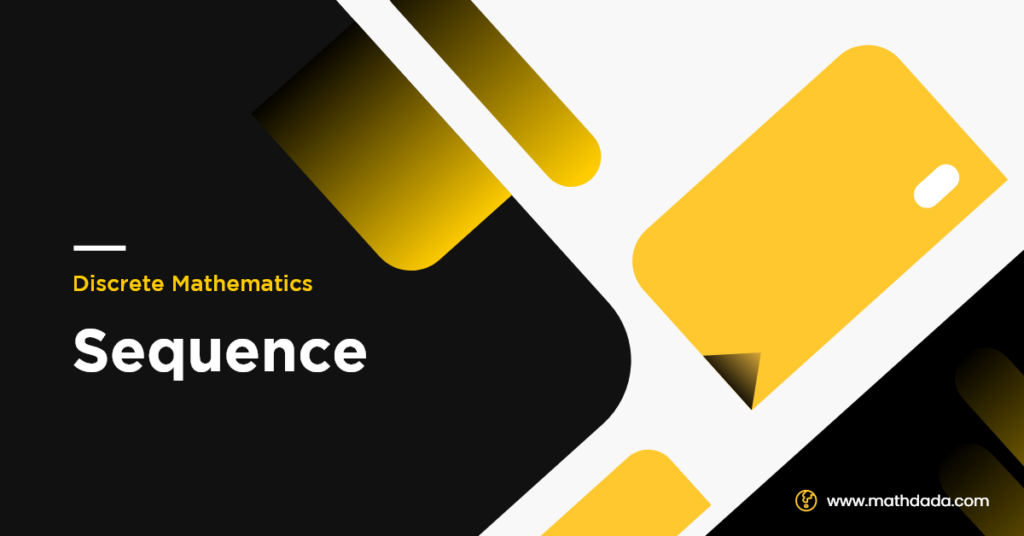Table of Contents
Introduction to Sequence
The concept of limit forms the basis of Calculus and distinguishes it from Algebra. The idea of the limit of a sequence, bounds of a sequence, limit of the sequence of partial sums of an infinite series plays an important part in Mathematical Analysis.
Greatest and Least Members of a Set
A number L is the greatest member of a set S of real numbers, if
(i) L is itself a member of S i.e., L\in S and
(ii) L ≥ x, where x is any element of the set S.
Similarly, l is the least member of a set S of real numbers, if
(i) l is a member of S, i.e., l\in S and
(ii) l ≤ x, where x is any member of the set S.
Examples
1. In the set of natural numbers {1, 2, 3, …, n, …}, 1 is the least member, but it has no greatest member.
2. For the sequence \left\{ 1,\frac{1}{2},\frac{1}{3},....,\frac{1}{n},... \right\}, 1 is the greatest member, but it has no least member.
3. For the set of numbers {4, 5, 6, 7, 8, 9, 10, 11}, 4 is the least member, while 11 is the greatest member.
Bounds of a Set
1. Given a set S of real numbers, if there exists a number G such that x ≤ G, for every member x of S, then we say that set S is bounded above and G is an upper bound of the set.
2. If there exists a number g, such that x ≥ g, for any member x of the set S, thus the set is bounded below and g is called a lower bound of the set.
Neighborhood of a Point: Points of Accumulation
1. Let, ξ be a real number and ε be an arbitrary positive number. Then the set of real numbers lying in the open interval (ξ – ε, ξ + ε) is called an ε-neighborhood of ξ.
It may be noted that for each separate choice of the arbitrary positive number ε, we may form a separate neighborhood of the number ξ.

2. Deleted Neighborhood: The set of all real numbers lying in the open interval (ξ – ε, ξ + ε), excluding the real number ξ is called deleted ε-neighborhood of ξ, where ε is an arbitrary positive number, however small
3. Point of Accumulation: A real number ξ, which may or may not belong to a set of real numbers, is called a point of accumulation or cluster point of S, if every neighborhood of ξ, however small, contains an infinite number of members of S. Cluster point is also called limiting point.
It should be noted that a finite set of real numbers cannot have any cluster point.
Sequence of numbers
A sequence of real numbers, or a real sequence, is defined as a function f:N\to R, where N is the set of natural numbers and R is the set of real numbers.
If f:N\to R is a sequence, then for each n\in N,f\left( n \right) is a real number. It is customary to write f\left( n \right)\,\,as\,\,{{x}_{n}}. So, a sequence is written as \left\{ {{x}_{1}},{{x}_{2}},{{x}_{3}},...,{{x}_{n}},... \right\}\,\,or\,\,\left\{ {{x}_{n}} \right\}
Alternatively, we may define a sequence in the following way,
A set of real numbers {{x}_{1}},{{x}_{2}},{{x}_{3}},...,{{x}_{n}},... such that corresponding to every positive integer n, there exists a real number {{x}_{n}} of the set, is called a sequence.
The individual members {{x}_{1}},{{x}_{2}},{{x}_{3}},... are called terms of the sequence. So x1 is the first term, x2 is the second terms, xn is the n-th term of the sequence\left\{ {{x}_{n}} \right\}.
Obviously, we can write all terms of a sequence if its n-th term is known.
If a sequence terminates after a finite number of terms, it is called a finite sequence; otherwise, it is an infinite sequence. In what follows, we shall be concerned with infinite sequence only and word infinite may not be used always.
Examples
1. {3, 5, 7, 9, 11} is a finite sequence.
2. \left\{ {{n}^{2}} \right\}=\left\{ 1,4,9,16,....,{{n}^{2}},.... \right\} is an infinite sequence.
3. \left\{ \frac{1}{n} \right\}=\left\{ 1,\frac{1}{2},\frac{1}{3},....,\frac{1}{n},... \right\} is an infinite sequence.
4. \left\{ {{\left( -1 \right)}^{n}} \right\}=\left\{ -1,1,-1,1,..... \right\} is an infinite sequence.
5. \left\{ 1+{{\left( -1 \right)}^{n}} \right\}=\left\{ 0,2,0,2,..... \right\} is an infinite sequence.
6. A sequence \left\{ {{x}_{n}} \right\} may also be defined by a recurrence relation viz {{x}_{n+1}}=\sqrt{2{{x}_{n}}},\,{{x}_{1}}=1
Here, the terms of the sequence are: 1,\sqrt{2},\sqrt{2\sqrt{2}},\sqrt{2\sqrt{2\sqrt{2}}},....
We note that the terms of a sequence may be all distinct as in examples 1, 2, 3, and 6 above, or the terms may be repeating as in examples 4 and 5.
The set of all the distinct elements of a sequence is called the range set of the given sequence.
The range set of the sequence is examples 1, 3 and 5 are {3, 5, 7, 9, 11}, \left\{ 1,\frac{1}{2},\frac{1}{3},....,\frac{1}{n},... \right\} and \left\{ 0,2 \right\} respectively.
Thus it follows that the range set of a sequence may be finite or infinite, even if the sequence has an infinite number of elements.
Bounds of a Sequence: Bounded Sequence
A sequence \left\{ {{x}_{n}} \right\} is said to be bounded above, if there exists a real number K such that xn ≤ K, for all n\in N
Here K is called an upper bound of the sequence \left\{ {{x}_{n}} \right\}.
Obviously, a sequence may have a number of rough upper bounds. Of all the upper bound, the least one is called the exact upper bound of the sequence.
Similarly, given a sequence \left\{ {{x}_{n}} \right\}, if there exists a number k, which is less than or equal to any number of the sequence, i.e., if k ≤ xn, for all n, then the sequence \left\{ {{x}_{n}} \right\} is said to be bounded below, k being called lower bound.
A sequence may have more than one rough lower bound, of all the rough lower bounds, the greatest one is called the exact lower bound.
If a sequence is bounded both above and below, it is called a bounded sequence.
Examples
1. The sequence {n + 1} = {2, 3, 4, …} is bounded below, the lower bound being 2, but not bounded above.
2. The sequence \left\{ 1+\frac{1}{n} \right\}=\left\{ 2,\frac{3}{2},\frac{4}{3},\frac{5}{4},\frac{6}{5},.... \right\} is bounded above, the upper bound being 2.
3. The sequence \left\{ {{\left( -1 \right)}^{n}} \right\}=\left\{ -1,1,-1,1,..... \right\} is bounded, since -1\le {{x}_{n}}\le 1, for all n\in N.
4. The sequence \left\{ x+{{\left( -1 \right)}^{n}}.\frac{1}{n} \right\}=\left\{ 1,2\frac{1}{2},\frac{5}{3},2\frac{1}{4},\frac{9}{5},.... \right\} is bounded, for it is bounded both above and below, the upper and the lower being 2\frac{1}{2} and 1 respectively.
5. The sequence \left\{ \frac{{{\left( -1 \right)}^{n-1}}}{n!} \right\}=\left\{ 1,-\frac{1}{2!},\frac{1}{3!},-\frac{1}{4!},.... \right\} is bounded, for -\frac{1}{2}\le {{x}_{n}}\le 1, for all \[n\in N.[/katex]
Monotonic Sequence
1. A sequence \left\{ {{x}_{n}} \right\} is said to be monotonic increasing if {{x}_{n}}\le {{x}_{n+1}} for all n\in N. The sequence is strictly increasing, if {{x}_{n}}<{{x}_{n+1}} for all n\in N.
2. A sequence \left\{ {{x}_{n}} \right\} is said to be monotonic decreasing if {{x}_{n}}\ge {{x}_{n+1}}for all n\in N.
The sequence is strictly increasing, if {{x}_{n}}>{{x}_{n+1}} for all n\in N.
A sequence is said to be a monotonic sequence, if it is either monotonic increasing or monotonic decreasing. Monotonic sequences are also called monotone sequence.
Examples
1. The sequence {n} = {1, 2, 3, ….} is monotonically increasing.
2. The sequence \left\{ {{2}^{n}}-1 \right\}=\left\{ 1,3,7,15,24,.... \right\} is monotonically increasing.
3. The sequence \left\{ \frac{1}{n} \right\}=\left\{ 1,\frac{1}{2},\frac{1}{3},....,\frac{1}{n},... \right\} is monotonically decreasing.
4. The sequence \left\{ {{\left( -1 \right)}^{n+1}} \right\}=\left\{ 1,-1,1,-1,.... \right\} is neither monotonically increasing or monotonically decreasing. So, \left\{ {{\left( -1 \right)}^{n+1}} \right\} is not a monotonic sequence.
Limit of a Sequence
An infinite sequence \left\{ {{x}_{n}} \right\} is said to have a finite limit l, if for any pre-assigned positive number ε, however small there corresponds a positive integer N such that \left| {{x}_{n}}-l \right|<\varepsilon for n > N.
The state of affairs is expressed as \underset{n\to \infty }{\mathop{\lim }}\,{{x}_{n}}=l
Note: The symbol n\to \infty means that n takes up successively an endless series of integral values which ultimately become and remain greater than any arbitrarily large assigned positive integer.
| Example 01 |
Find the limit of the sequence \left\{ \frac{1}{n} \right\}\,\,as\,\,n\to \infty .
Solution:
We observe that, here \left| \frac{1}{n}-0 \right|<\varepsilon ,\,\,for\,\,n<\frac{1}{\varepsilon }
Taking N=\frac{1}{\varepsilon } or, the integral part of ε, when ε is a fraction, we may write \left| \frac{1}{n}-0 \right|<\varepsilon ,\,\,if\,\,n\ge N
\therefore \,\,\underset{n\to \infty }{\mathop{\lim }}\,\,\,\frac{1}{n}=0
| Example 02 |
Show that \underset{n\to \infty }{\mathop{\lim }}\,\,\,{{x}_{n}}=1, where {{x}_{n}}=1+\frac{{{\left( -1 \right)}^{n}}}{n}
Solution:
If ε > 0 be any number, \left| {{x}_{n}}-1 \right|=\left| 1+\frac{{{\left( -1 \right)}^{n}}}{n}-1 \right|=\frac{1}{n}<\varepsilon ,\,\,if\,n>\frac{1}{\varepsilon }
If M be a positive integer > \frac{1}{\varepsilon }, then \left| {{x}_{n}}-1 \right|<\varepsilon , for all n ≥ M
Hence, \underset{n\to \infty }{\mathop{\lim }}\,\,\,{{x}_{n}}=1
Convergent Sequence
An infinite sequence \left\{ {{x}_{n}} \right\} is said to be convergent and converges to l, if corresponding to any arbitrary small positive number ε, we can find a positive integer N, depending on ε, such that
\[\left| {{x}_{n}}-l \right|<\varepsilon ,\,\,for\,\,n\ge N\]
\[i.e.,\,\,l-\varepsilon <{{x}_{n}}<l+\varepsilon \,\,when\,\,n\ge N\,\]
The number l is called the limit of the sequence \left\{ {{x}_{n}} \right\} and is written as \underset{n\to \infty }{\mathop{\lim }}\,{{x}_{n}}=l
| Example 03 |
The sequence \left\{ {{x}_{n}} \right\}, where {{x}_{n}}=2-\frac{1}{{{2}^{n}}}, is convergent.
Solution:
Here, \left| {{x}_{n}}-2 \right|=\left| -\frac{1}{{{2}^{n}}} \right|=\frac{1}{{{2}^{n}}}
Let, ε > 0 be given,
Then \left| {{x}_{n}}-2 \right|<\varepsilon ,\,\,if\,\,\frac{1}{{{2}^{n}}}<\varepsilon \Rightarrow {{2}^{n}}>\frac{1}{\varepsilon }
Now, {{2}^{n}}>\frac{1}{\varepsilon }\,\,gives\,\,n\log 2>\log \left( \frac{1}{\varepsilon } \right)\Rightarrow n>\frac{\log \left( \frac{1}{\varepsilon } \right)}{\log 2}
If M be a positive integer \ge \frac{\log \left( \frac{1}{\varepsilon } \right)}{\log 2}
Thus \left| {{x}_{n}}-2 \right|<\varepsilon ,\,\,for\,\,n\ge M
Hence, \underset{n\to \infty }{\mathop{\lim }}\,\,{{x}_{n}}=2
Thus the sequence \left\{ {{x}_{n}} \right\} is convergent and converges to 2.
Note: The limit of a sequence may or may not be a term of the sequence. For, the convergent sequence \left\{ 1,\frac{1}{2},\frac{1}{3},....,\frac{1}{n},.... \right\} has the limit 0, but no term of the sequence is 0.
Non-Convergent Sequence
A sequence \left\{ {{x}_{n}} \right\} is said diverge to +∞, if for any number G, however large, is assigned, there corresponds a positive integer N, such that xn > G, for all n > N.
This situation is expressed symbolically as \underset{n\to \infty }{\mathop{\lim }}\,\,{{x}_{n}}=\infty
In this case, the sequence is called divergent.
A sequence is said to diverge to –∞, if when any number g whatever is assigned, there always exists a positive integer N, such that xn < g, for all n ≥ N and we write \underset{n\to \infty }{\mathop{\lim }}\,\,{{x}_{n}}=-\infty
Here, g is generally chosen as a negative number, large in absolute value.
Divergent Sequence
A sequence which diverges to either +∞ or –∞, is said to be a divergent sequence.
Non-Divergent Sequence
A sequence which diverges to neither +∞ nor –∞ is said to be a non-divergent sequence.
Examples
1. The sequence \left\{ {{2}^{n}} \right\}=\left\{ 2,4,8,16,32,.... \right\} diverges to +∞.
2. The sequence \left\{ -{{n}^{2}} \right\}=\left\{ -1,-4,-9,-16,.... \right\} diverges to –∞.
3. The sequence \left\{ {{\left( -1 \right)}^{n}}.n \right\}=\left\{ -1,2,-3,4,-5,.... \right\} neither diverges to +∞ nor diverges to –∞.
Oscillatory Sequence
A sequence which is neither convergent, nor divergent, is called an oscillatory sequence.
A sequence is said to oscillate finitely, if
(i) it is bounded,
(ii) it neither converges nor diverges.
A sequence is said to oscillate infinitely, if
(i) it is not bounded and
(ii) it neither converges, nor diverges.
Examples
1. The sequence \left\{ 1+{{\left( -1 \right)}^{n}} \right\}=\left\{ 0,2,0,2,0,2,..... \right\} oscillates finitely.
2. The sequence \left\{ {{\left( -1 \right)}^{n}}.n \right\}=\left\{ -1,2,-3,4,-5,6,.... \right\} oscillates infinitely.
Functions |
Counting and Combinatorics |


